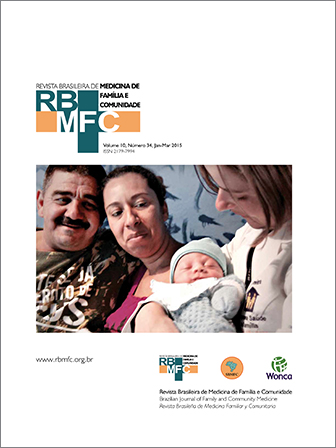Dental fluorosis associated with chronic ingestion of dentifrices – what health professionals should know
DOI:
https://doi.org/10.5712/rbmfc10(34)812Keywords:
Fluorosis, Dental, Dentifrices, ChildAbstract
This paper reports on two cases of dental fluorosis caused by inadvertent ingestion of fluoridated dentifrice. An eight-year-old child showed whitish spots and loss of dental enamel in first permanent molars and whitish spots without structure loss in permanent incisors and primary second molars, whereas a fourteen-year-old teenager showed whitish spots in all permanent teeth. In both cases, homologue teeth were affected similarly and mothers did not report on the use of fluoride supplements during pregnancy or children’s infancy. The water fluoridation of the city where they live is considered optimal. Both patients reported eating dentifrice frequently during tooth brushing and in other occasions. Mothers also stated that they did not receive instructions about oral hygiene or about the fact that chronic ingestion of dentifrice could contribute to the development of dental fluorosis. It is believed that the cooperative work between dentists and other health professionals is a way to prevent the occurrence of this condition.
Downloads
Metrics
References
Hong L, Levy SM, Broffitt B, Warren JJ, Kanellis MJ, Wefel JS, et al. Timing of fluoride intake in relation to development of fluorosis on maxillary central incisors. Community Dent Oral Epidemiol. 2006;34:299-309. http://dx.doi.org/10.1111/j.1600-0528.2006.00281.x DOI: https://doi.org/10.1111/j.1600-0528.2006.00281.x
Rojas-Sanchez F, Kelly SA, Drake KM, Eckert GJ, Stookey GK, Dunipace AJ. Fluoride intake from foods, beverages and dentifrice by young children in communities with negligibly and optimally fluoridated water: a pilot study. Community Dent Oral Epidemiol. 1999;27:288–97. http://dx.doi.org/10.1111/j.1600-0528.1999.tb02023.x DOI: https://doi.org/10.1111/j.1600-0528.1999.tb02023.x
Almeida BS, Silva Cardoso VE, Buzalaf MA. Fluoride ingestion from toothpaste and diet in 1- to 3-year-old Brazilian children. Community Dent Oral Epidemiol. 2007;35:53-63. http://dx.doi.org/10.1111/j.1600-0528.2007.00328.x DOI: https://doi.org/10.1111/j.1600-0528.2007.00328.x
Ellwood RP, Cury JA. How much toothpaste should a child under the age of 6 years use? Eur Arch Paediatr Dent. 2009;10:168-74. http://dx.doi.org/10.1007/BF03262679 PMid:19772847 DOI: https://doi.org/10.1007/BF03262679
Naccache H, Simard PL, Trahan L, Brodeur JM, Demers M, Lachapelle D, et al. Factors affecting the ingestion of fluoride dentifrice by children. J Public Health Dent. 1992;52(4):222–6. http://dx.doi.org/10.1111/j.1752-7325.1992.tb02277.x DOI: https://doi.org/10.1111/j.1752-7325.1992.tb02277.x
Kobayashi CAN, Belini MR, Italiani FM, Pauleto ARC, Araújo JJ, Tessarolli V, et al. Factors influencing fluoride ingestion from dentifrice by children. Community Dent Oral Epidemiol. 2011;39:426–32. http://dx.doi.org/10.1111/j.1600-0528.2011.00615.x DOI: https://doi.org/10.1111/j.1600-0528.2011.00615.x
Oliveira MJL, Paiva SM, Martins LHPM, Pordeus IA, Lima YBO, Cury JA. Influence of rinsing and expectoration after toothbrushing on fluoride dose and ingested amount by use of conventional and children’s fluoride dentifrices. Bras Dent J. 2006;17(2):100-5. http://dx.doi.org/10.1590/S0103-64402006000200003 DOI: https://doi.org/10.1590/S0103-64402006000200003
Oliveira MJ, Paiva SM, Martins LH, Ramos-Jorge ML, Lima YB, Cury JA. Fluoride intake by children at risk forthe development of dental fluorosis:comparison of regular dentifrices andflavoured dentifrices for children. Caries Res. 2007;41:460-6. http://dx.doi.org/10.1159/000107933 DOI: https://doi.org/10.1159/000107933
Moraes SM, Pessan JP, Ramires I, Buzalaf MAR. Fluoride intake from regular and low fluoride dentifrices by 2-3-year-old children: influence of the dentifrice flavor. Braz Oral Res. 2007;21(3):234-40. http://dx.doi.org/10.1590/S1806-83242007000300008 DOI: https://doi.org/10.1590/S1806-83242007000300008
Martins CC, Oliveira MJ, Pordeus IA, Cury JÁ, Paiva SM. Association between socioeconomic factors and the choice of dentifrice and fluoride intake by children. Int J Environ Res Public Health. 2011,8,4284-99. http://dx.doi.org/10.3390/ijerph8114284 DOI: https://doi.org/10.3390/ijerph8114284
Cutress TW, Suckling GW. Differential diagnosis of dental fluorosis. J Dent Res. 1990;69:714-20. DOI: https://doi.org/10.1177/00220345900690S138
Pendrys DG. Analytical studies of enamel fluorosis: methodological considerations. Epidemiol Rev. 1999;21(2):233-46. Available from: http://epirev.oxfordjournals.org/content/21/2/233.full.pdf+html DOI: https://doi.org/10.1093/oxfordjournals.epirev.a017999
Cury JA, Del Fiol FS, Tenuta LM, Rosalen PL. Low fluoride dentifrice and gastrointestinal fluoride absorption alter meals. J Dent Res. 2005;84:1133-7. http://dx.doi.org/10.1177/154405910508401208 DOI: https://doi.org/10.1177/154405910508401208
Miziara AP, Philippi ST, Levy FM, Buzalaf MA. Fluoride ingestion from food items and dentifrice in 2-6-year-old Brazilian children living in a fluoridated area using a semiquantitative food frequency questionnaire. Community Dent Oral Epidemiol. 2009;37:305-15. http://dx.doi.org/10.1111/j.1600-0528.2009.00477.x DOI: https://doi.org/10.1111/j.1600-0528.2009.00477.x
Puppin Rontani RM, Correa Kassawara AB, Delgado Rodrigues CR. Influence of socioeconomic level and dentifrice brand on the oral hygiene habits and fluoride dentifrice ingestion. J Clin Pediatr Dent. 2002;26:319-25. DOI: https://doi.org/10.17796/jcpd.26.3.ul4v10t21x07v718
Vilhena FV, Olympio KP, Lauris JR, Delbem AC, Buzalaf MA. Low-fluoride acidic dentifrice: a randomized clinical trial in a fluoridated area. Caries Res. 2010;44:478-84. http://dx.doi.org/10.1159/000320364 DOI: https://doi.org/10.1159/000320364
Vallée JG, Kandelman D. Knowledge, attitudes and practices of physicians west of Montreal Island regarding fluoride and the prevention of dental fluorosis. Can J Public Health. 1993;84(2):94-8. Available from: http://www.ncbi.nlm.nih.gov/pubmed/8334616
Balaban R, Aguiar CM, da Silva Araújo AC, Dias Filho EB. Knowledge of paediatricians regarding child oral health. Int J Pediatr Dent. 2012 Jul;22(4):286-91. http://dx.doi.org/10.1111/j.1365-263X.2011.01196.x DOI: https://doi.org/10.1111/j.1365-263X.2011.01196.x
Downloads
Published
How to Cite
Issue
Section
License
By submitting a manuscript to the RBMFC, authors retain ownership of the copyright in the article, and authorize RBMFC to publish that manuscript under the Creative Commons Attribution 4.0 license and identify itself as the vehicle of its original publication.















